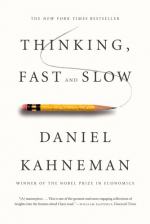
|
| Name: _________________________ | Period: ___________________ |
This quiz consists of 5 multiple choice and 5 short answer questions through Chapters 25 - 29.
Multiple Choice Questions
1. What do we lose touch with when we are uncomfortable or unhappy?
(a) Articulation.
(b) Admiration.
(c) Intuition.
(d) Recognition.
2. The author notes that stereotyping is a negative word in our society. How does the author apply the word in his usage?
(a) Caustic.
(b) Neutral.
(c) Positive.
(d) Tragic.
3. The author states in the opening of Chapter 29, "Whenever you form a global evaluation of a complex object--a car you may buy, your son-in-law, or an uncertain situation--you" do what (600)?
(a) "Seek advice from experience."
(b) "Make immediate assumptions."
(c) "Evaluate the normalcy of the events or subjects."
(d) "Assign weights to its characteristics."
4. What book did Abert Michotte write in 1945?
(a) Introduction to the Mind and Morals.
(b) The Moses Illusion.
(c) Introduction to Cognitive Pupillometry.
(d) The Perception of Causality.
5. Who wrote Judgment in Managerial Decision Making?
(a) John List.
(b) Max Bazerman.
(c) Christopher Hsee.
(d) Gary Klein.
Short Answer Questions
1. What psychologist demonstrated disgust by relating that one cockroach could ruin the appeal of a bowl of cherries, but that one cherry would not do anything for a bowl of cockroaches?
2. In the example where the author presents two candidates for a college professorship, which individual is described as recently completing her graduate work?
3. Cognitive strain is defined by the author as being affected by both the current level of effort and what?
4. The author states in Chapter 26, "In mixed gambles, where both a gain and a loss are possible," what happens (552)?
5. How many of the participants in Nisbett's experiment at the Univerity of Michigan never got out of their booth when the stooge pleaded for help?
|
This section contains 297 words (approx. 1 page at 300 words per page) |

|




